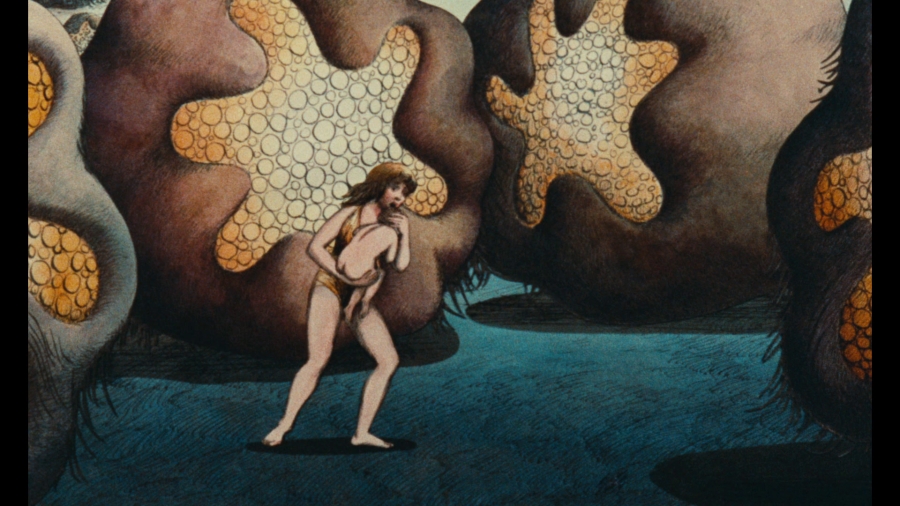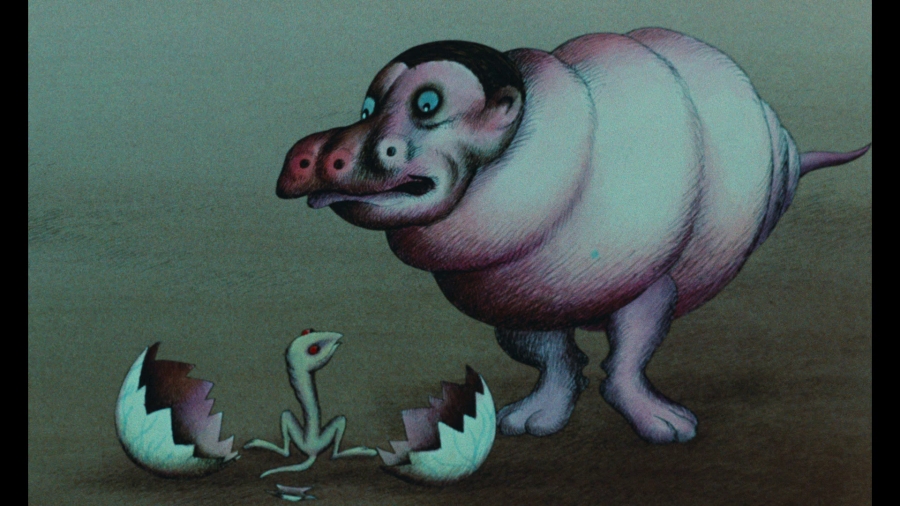Fantastic Planet

See more details, packaging, or compare
Synopsis
Nothing else has ever looked or felt like director René Laloux’s animated marvel Fantastic Planet, a politically minded and visually inventive work of science fiction. The film is set on a distant planet called Ygam, where enslaved humans (Oms) are the playthings of giant blue natives (Draags). After Terr, kept as a pet since infancy, escapes from his gigantic child captor, he is swept up by a band of radical fellow Oms who are resisting the Draags’ oppression and violence. With its eerie, coolly surreal cutout animation by Roland Topor; brilliant psychedelic jazz score by Alain Goraguer; and wondrous creatures and landscapes, this Cannes-awarded 1973 counterculture classic is a perennially compelling statement against conformity and violence.
Picture 8/10
René Laloux’s Fantastic Planet comes to Blu-ray in North America thanks to Criterion, who presents the film in its original aspect ratio of 1.66:1. The new 1080p/24hz high-definition presentation is delivered on a dual-layer disc and comes from a new 2K restoration at Éclair/Groupe Ymagis by Argos Films and the CNC. The scan comes from the original 35mm negative.
We get a very nice, fresh looking presentation that retains a naturally filmic look. The print has been cleaned up rather thoroughly and other than some minor fluctuations in the image (that more than likely are a byproduct of the animation) I don’t recall any other blemishes appearing.
The colour scheme to the film is drastically different in comparison to the previous video releases I’ve seen, including the Masters of Cinema DVD (as a note, as of this writing, I have not seen the Masters of Cinema Blu-ray yet). These older releases presented a fairly warm looking colour scheme, though admittedly the colours had a tendency to look a little washed out. I thought colour saturation offered a vast improvement here, but the colours are also far cooler. It’s noticeable right off during the opening sequence, but not too bad and didn’t look too far removed from how I had previously seen the film: the skin tones of the humans (Oms) still hold a pinkish hue and the yellows still looked yellow. But then scattered throughout, and then more periodically after Terr finds himself with a group of wild Oms, the colder blue gets really heavy. The skin tones get paler with a more obvious blue hue, and other colours take on a heavy blue shift, but then we’ll jump to a scene where the blue hue is then toned down.
Admittedly I found this very odd, and it did throw me off. I’m sure I feel this way because of the older presentations that I’ve gotten used to over the years. The older releases probably looked a little too yellow-ish in places, but the shift here can be really drastic. I don’t know which colour scheme is the true one, but honestly there were moments here where it just felt a little heavy. But, after saying that, the supplements present conflicting bits of evidence (though still weak evidence either way) as to how the film should look. There are clips shown in the various supplements—none of which were made exclusively for this release—that show the warmer, more familiar tone, which the trailer also shows. But artwork created by Tapor that Laloux shows in one interview shows colours that match what is here, pretty much exactly. Also, in an extended television program from 1974 about Roland Tapor, we get clips from the film that are even bluer than what is here.
Despite that one factor the digital presentation is otherwise solid. The nice thing to see is that film grain remains and it looks beautifully rendered with no digital problems of note. The level of detail in the image is also staggering and the artwork has never looked so sharp and crisp, where the finer line work comes through far clearer. The encode is very clean and no digital issues popped up.
In the end I was admittedly thrown by the colours, and despite them maybe feeling off in places, I can’t say either way whether they’re wrong or right. But the clean-up job and the filmic quality of the presentation are both huge improvements.








































Audio 7/10
The film presents both the original French track, presented in lossless linear PCM mono, and an optional English track, presented in Dolby Digital mono.
Of the two the French track is clearly the better one. It’s received a lot of restoration work and sounds almost new. The track is not only clean and free of background noise, but music and voices present excellent fidelity and range, and the mix is balanced is nicely.
The English track, on the other hand, is flat and lifeless, with no fidelity or depth. Range is limited and it comes off fairly one note in the end. There’s also faint background noise.
It will end up coming down to personal preference obviously, but the French track is clearly the better presentation and I was disappointed the English track didn’t receive the same attention.
Extras 7/10
Criterion’s special edition offers a nice selection of supplements, starting with two short films made by René Laloux and Roalnd Tapor: Les temps morts and Les escargots. Les temps morts is made up of stock footage, Tapor’s illustrations, and minimal animation, almost acting as a sort of documentary about mankind made by some being from another planet, who sees the human race as naturally violent beings. Les escargots is a cute if odd film about a farmer unsuccessfully trying to grow his crop. He eventually discovers that his tears make them grow and they become so large they attract destructive, giant snails. Running 10-minutes and 11-minutes respectively, they’re both excellent additions, though I’m unsure why only these two shorts were the ones included. Also, Les escargots is presented in high-definition and looks fabulous, while Les temps morts has sadly only been upscaled from a standard-definition source.
Following the shorts is Laloux sauvage, a 2009 documentary about the filmmaker, made up of interview footage with him and producer André Valio-Cavaglione filmed in 2001. Laloux gives an amusing backstory to his birth and childhood (born just as the Great Depression was starting) and then talks about his work with the mentally ill at the Loire Valley clinic and the animated films he made with them: Tic-Tac and Monkey Teeth.This led to his beginnings as a filmmaker and the short films he would make with Roland Tapor. A good chunk of the 26-minute feature focuses on the production of Fantastic Planet, Laloux talking about its origins and then going to Prague for cheap labour (the Russian invasion shut the project down for a few years). Sadly it doesn’t spend a lot of time on his later works, with Laloux suggesting through passive comments that he’s disappointed with these works. At any rate, despite its short length, I found it an informative piece.
Criterion then includes a couple of features around artist Roland Tapor. The first comes from an episode of the French program Italiques filmed in 1974. The 53-minute program is a bit off beat, starting off with the crew appearing to start the interview by setting up shop in his room and waking him out of bed. Throughout they have extensive discussions with Tapor about his early life and his work, also getting interviews with friends and family, including his father, Abram Tapor. Tapor’s an off-kilter guy, which lends to the off-kilter feel of the program (and his laugh is both delightful yet frightening at the same time), but the program, which also looks at Fantastic Planet (and shows those super blue clips I mentioned in the “Picture” portion of this article), offers a great profile of the man.
Criterion also includes a short 3-minute interview with Tapor filmed in 1973 for the program Pop deux. Here Tapor focuses a bit more on the financial side of things, which he touches on in the other feature. Again, it shows his off-kilter humour.
The disc then closes with the film’s theatrical trailer and the large fold-out insert features an excellent essay written by Michael Brooke on Laloux, Tapor, the film’s production in Czechoslovakia, and then Laloux’s later life before his death in 2004. The release was lacking a scholarly slant in the disc supplements so this essay nicely makes up for it.
In all I guess I was hoping for maybe a little more in the academic area, maybe more on the animation (I was able to pick up pieces on it in the supplements, but one big feature would have been nice) but as it is Criterion has still put together a nice set of material.
Closing
The colours will cause a stir (and there have already been freakouts online, not too surprisingly) and they admittedly threw me off at times. As to whether they’re right or not I can’t say. They certainly feel “off” at times but then even the supplements here present conflicting looks. But the digital transfer itself is solid, very filmic in look, and the restoration work has been very thorough: in this regard the presentation is sharp. Accompanied by some solid supplements, including some very fascinating ones exposing the intriguing personality of Roland Tapor, it’s a solid little special edition.







